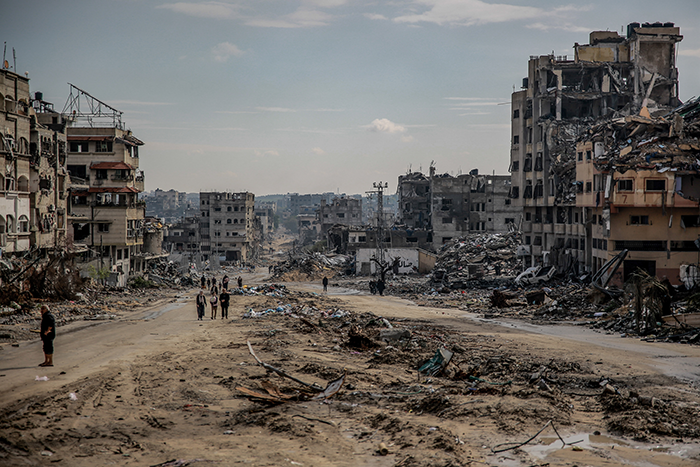Interviews / Human Security
28 March 2024
Gaza: The Humanitarian Emergency

While Israeli bombings have killed more than 30,000 people in the Gaza Strip, the Palestinian population must also contend with the severe humanitarian consequences of the conflict. Numerous trucks are positioned on the Egyptian side, waiting to be allowed entry to deliver humanitarian aid. Also facing a maritime and aerial blockade, the fear of widespread famine across the entire Palestinian territory remains. What are the humanitarian aid needs, and what challenges are being encountered? How is the international community responding to this looming catastrophe? An interview with Jean-François Corty, associate researcher at IRIS and vice-president of Médecins du Monde.
Since the Israeli offensive and bombings following Hamas’s attacks, how has the humanitarian situation in the Gaza Strip evolved?
The Gaza Strip is currently facing a catastrophic human and humanitarian situation because the effects of the near-total maritime, aerial, and land blockade imposed by the Israeli army since 7 October are being keenly felt. Before the Israeli military operations in October, 600 to 700 trucks per day entered Gaza to deliver essential goods needed for the population, as the territory is not self-sufficient to meet its various needs. The blockade now allows only limited aid to enter, mostly in the southern part of the Gaza Strip, while bombings have destroyed more than half of the infrastructure, caused over 30,000 deaths, and injured 70,000 people.
These factors have created a dramatic humanitarian situation with a healthcare system that is almost completely overwhelmed and unable to meet needs, alongside insufficient access to nutritional aid and medicines. Of the thirty hospitals in Gaza, only a few are partially operational, and many are at capacity: the last functioning hospital, Al-Shifa in Gaza, is under military threat, while in Rafah in the south, the few operational healthcare facilities are overburdened, running at 300% capacity. Essentially, there is a siege within the siege, with the northern and central parts of Gaza experiencing even tighter restrictions, with virtually no aid entering these areas. Between 300,000 and 500,000 people are in extreme destitution, with malnutrition rates worsening daily. A famine is emerging, and according to recent IPC reports, it could spread across the northern and central territories by April-May and to the entire Gaza Strip, including Rafah, by July if the situation remains unchanged.
There is also a high mortality rate due to bombings, lack of medical care, and problems with access to food and water. In the south, nutritional stress is significant, with alarming indicators, yet the limited aid that arrives remains insufficient. Even though some food is available at market stalls, many people cannot afford it as prices are exorbitant. Around 1.5 million people in Rafah live in extreme precarity, most under tents, in makeshift camps on the beach, or in their cars.
As a large proportion of the Palestinian population is now concentrated in the city of Rafah in the south, how is aid being delivered locally? What challenges does humanitarian assistance face?
Under these conditions, the aid is insufficient, and humanitarian workers—both national and international—cannot operate effectively across most of the Gaza Strip. The aid itself is largely prepositioned, particularly on the Egyptian side, where for the past four months, NGOs, humanitarian organisations, the United Nations, and some states have been stockpiling water, food, fuel, medicine, etc. Deliveries are made by land, which remains the most effective solution to meet the immense needs of over 2 million people across the north, centre, and south.
The mobilisation of aid is not the main issue since it is available. The challenge today lies in ensuring its entry and distributing it with teams on the ground. Due to the nutritional crisis, attempts at improvised aid distributions—whether by the Israeli army or other actors—have resulted in dozens or even hundreds of deaths due to stampedes or shootings. In this context, organising distributions requires professional expertise.
If professional teams cannot accompany large quantities of goods, if there are no secure stocks, and if beneficiary flows cannot be organised under proper conditions, then humanitarian aid becomes ineffective and even dangerous.
A few days ago, UN Secretary-General Antonio Guterres visited Egypt near the Gaza border and spoke of “ending the nightmare.” What role does the international community play in delivering humanitarian aid? Which states are the most engaged?
There is a degree of cynicism in state-led humanitarian aid, as it is being exploited by most European countries and the Americans. Washington announced ten days ago the deployment of a humanitarian corridor, notably by sea, with ships arriving from Cyprus that would dock at a jetty expected to be operational within 60 days. However, it is unclear where this plan stands today. In the context of fatalities from bombings and the blockade, 60 days could mean at least 10,000 to 15,000 additional deaths. This reveals the posturing of these states, coupled with the operational absurdity of attempting to deliver aid by sea: the quantities carried by the two or three ships that have reached Gaza (approximately 200 tons per ship) are equivalent to what five to ten trucks can deliver. These trucks are already prepositioned in their hundreds, ready to cross by land from Egypt. The issue is therefore not logistical since the aid is available but political, requiring a ceasefire to allow its massive entry.
A few weeks ago, the United States vetoed a request for an immediate ceasefire that would have enabled large-scale humanitarian aid to enter Gaza. Moreover, they continue to supply the Israeli army with the weaponry needed to pursue the war.
European and American states use humanitarian aid to depoliticise the context and avoid addressing the root causes more assertively, despite some diplomatic shifts. They appropriate the humanitarian cause by feigning interest in insufficient maritime routes and dangerous, imprecise aerial drops—although these do not negate the necessity of land-based deliveries. Western powers, which have significant influence over Israel, remain limited to offering token humanitarian assistance while refraining from more forcefully addressing the factors behind the 30,000+ deaths and 70,000+ injuries, many of which involve children. These factors include the air, maritime, and land blockade by the Israeli army, which aims to cause mass casualties; the repeated bombings that obliterate entire neighbourhoods and towns; and the inability of humanitarian workers to operate effectively.
A strong pressure campaign has also been directed at the United Nations Relief and Works Agency for Palestine Refugees in the Near East (UNRWA), a major humanitarian actor that is vital to assistance in this context. Regular attacks on the UN and UNRWA, including diplomatic and physical ones, have been an ongoing strategy, with over 150 UNRWA staff members killed in Gaza.
Within the international community, the United States holds unique leverage over Israel, but most European states have fallen short of the challenge by maintaining minimal humanitarian aid that fails to address the survival needs of Palestinians or halt the ongoing annihilation of civilians. A resolution proposed last weekend by the United States, vetoed by China and Russia, lacked any immediate call for action, instead suggesting a ceasefire should be considered soon. A non-binding resolution was passed on 25 March 2024, calling for a truce during Ramadan to open the door to a longer ceasefire, including the release of hostages and prisoners. The United States abstained. Israeli Prime Minister Netanyahu has shown no inclination to comply, and bombings in Gaza continue. Nevertheless, a slight shift in rhetoric can be observed from Western states, which previously spoke of “unconditional support.”
The current situation carries the real risk of genocide, as highlighted by the International Court of Justice. The court has stated that if aid does not enter Gaza massively, the genocide hypothesis could be confirmed. On the ground, aid is still not entering on a large enough scale. This could explain the evolving diplomatic rhetoric, particularly from Washington, even as military support for Israel persists. A ceasefire is undeniably necessary to stop the mass killings and ensure aid can flow into Gaza, as the situation worsens daily for Palestinian civilians. In the West Bank, NGO work is also challenging, with many civilian casualties, active settlement expansion, and administrative and security constraints further complicating humanitarian efforts.

